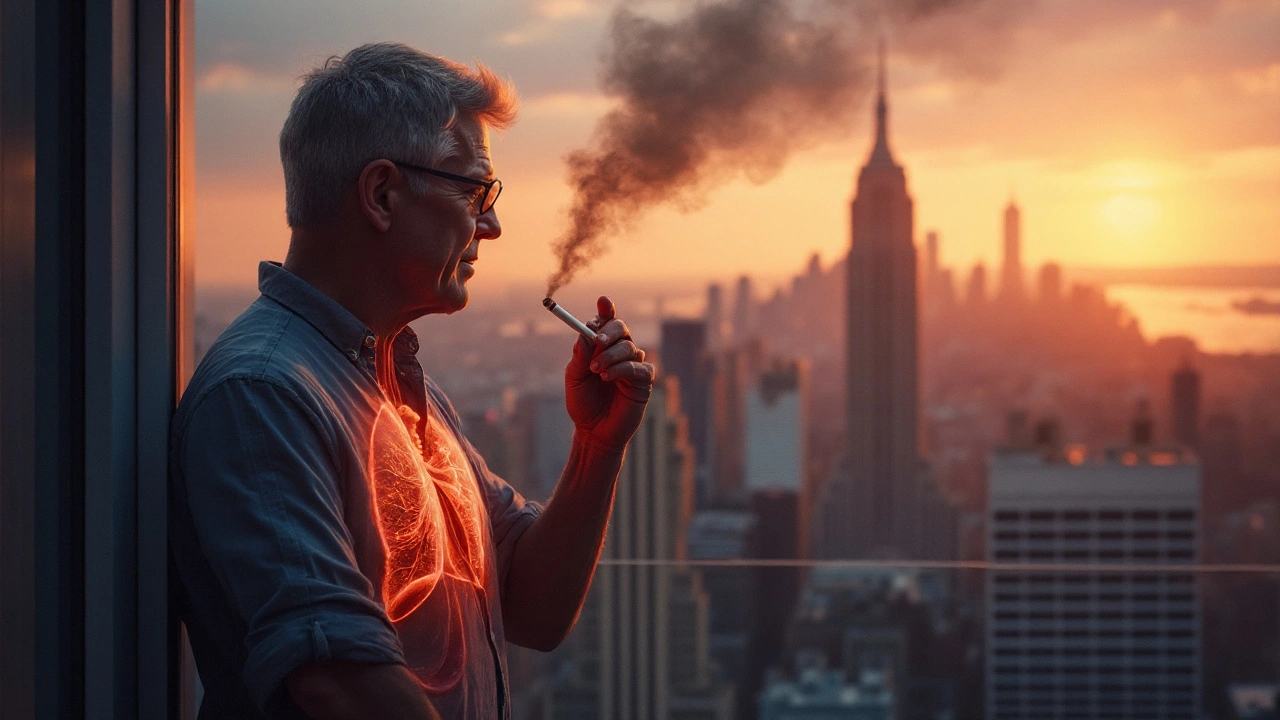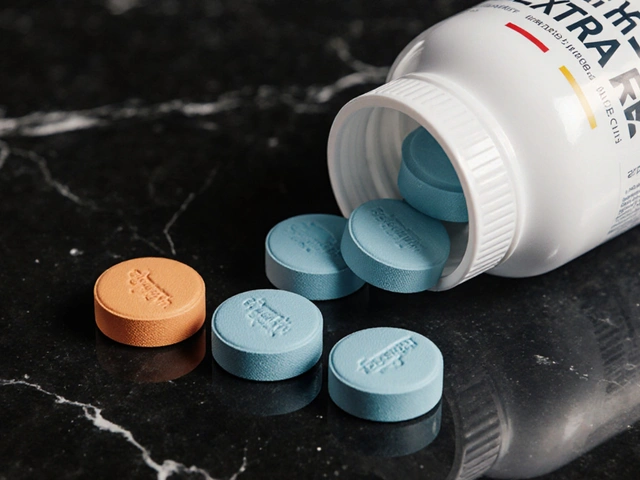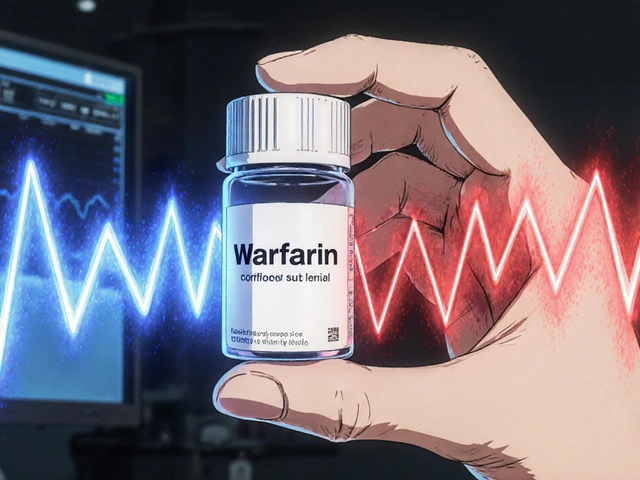Smoking‑Related Bronchospasm Risk Calculator
Bronchospasm is a sudden, involuntary tightening of the smooth muscles surrounding the airways, which restricts airflow and causes wheezing, coughing, and shortness of breath. When a smoker lights up, a cascade of chemicals hits the lungs, often tipping the delicate balance that keeps the bronchi open. Understanding that cascade is the first step toward breaking it.
Why Smoking Sets Off Bronchospasm
Every puff delivers nicotine, tar, carbon monoxide, and thousands of other irritants. Nicotine is a potent alkaloid that stimulates the sympathetic nervous system and triggers the release of catecholamines. Those catecholamines cause the vagus nerve to fire, prompting the airway smooth muscle to contract-an instant bronchoconstriction response.
Beyond nicotine, Oxidative stress is a state where free radicals overwhelm the body’s antioxidant defenses. Smoke‑borne free radicals attack the epithelial lining, damaging cells and releasing inflammatory mediators such as leukotrienes and prostaglandins. These mediators heighten airway hyperresponsiveness, a condition where the bronchi overreact to otherwise harmless stimuli, setting the stage for bronchospasm.
The combined effect of direct neural stimulation, oxidative injury, and inflammation creates a perfect storm. Even a single cigarette can provoke a measurable drop in forced expiratory volume (FEV1) within minutes, and regular smokers experience a progressive, often irreversible, decline in lung function.
Clinical Impact: Asthma vs. COPD
Both asthma and chronic obstructive pulmonary disease (COPD) feature bronchospasm, but the underlying pathology and response to smoking differ.
| Attribute | Asthma | COPD |
|---|---|---|
| Primary cause of bronchospasm | Allergic inflammation, eosinophils | Chronic irritant exposure, neutrophilic inflammation |
| Reversibility (FEV1 improvement after bronchodilator) | ≥12% and 200ml (high) | ≤12% and 200ml (low) |
| Smoking dose‑response | Exacerbates symptoms, lowers threshold for triggers | Accelerates disease progression, markedly reduces lung capacity |
| Typical age of onset | Childhood-young adult | Middle age-older adult |
| Response to inhaled corticosteroids | Good | Modest |
These differences matter when clinicians decide how aggressively to push smoking cessation, choose bronchodilators, or prescribe anti‑inflammatory therapies.
Risk Factors and Dose‑Response Relationship
Not all smokers develop severe bronchospasm. Several modifiers influence risk:
- Pack‑year history: Each pack‑year (one pack per day for one year) raises the odds of a clinically significant bronchospasm episode by roughly 5%.
- Age of initiation: Starting before age 15 triples the likelihood of chronic airway hyperresponsiveness later in life.
- Genetic predisposition: Polymorphisms in the CHRNA5 gene, which affect nicotine receptor sensitivity, correlate with heightened airway reactivity.
- Secondhand smoke exposure: Non‑smokers living with a smoker experience a 30% increase in bronchospasm episodes, especially children with asthma.
Even low‑level exposure matters. A study from the Australian Institute of Health (2023) found that occasional weekend smokers showed a 12% reduction in peak expiratory flow compared with never‑smokers.
Diagnosing Smoking‑Induced Bronchospasm
Clinicians start with history and physical exam, then confirm with objective testing.
- Spirometry: Measures FEV1 and forced vital capacity (FVC). A >10% post‑bronchodilator improvement suggests reversible bronchospasm.
- Bronchial provocation test: Methacholine or histamine challenges reveal hyperresponsiveness thresholds.
- Exhaled nitric oxide (FeNO): Elevated levels point to eosinophilic inflammation, common in asthma‑related bronchospasm.
- Imaging: High‑resolution CT can rule out structural lung disease that mimics bronchospasm.
Tracking trends over time helps differentiate acute smoke‑triggered episodes from chronic disease progression.

Management Strategies
The most powerful tool is quitting smoking. When cessation succeeds, airway inflammation begins to recede within weeks, and lung function can stabilize or improve.
- Smoking cessation programs: Combine behavioral counseling, nicotine replacement therapy (NRT), and, when appropriate, prescription meds like varenicline.
- Bronchodilators: Short‑acting beta‑agonists (SABAs) provide rapid relief. Long‑acting agents (LABAs) reduce nighttime symptoms.
- Inhaled corticosteroids (ICS): Suppress eosinophilic inflammation, especially beneficial for asthma patients.
- Anticholinergics: Tiotropium mitigates muscarinic‑mediated bronchoconstriction, useful in COPD‑related bronchospasm.
- Pulmonary rehabilitation: Exercise training improves ventilatory efficiency and reduces perception of breathlessness.
Adjunct therapies such as leukotriene receptor antagonists (e.g., montelukast) can target the inflammatory cascade triggered by smoke‑derived oxidants.
Related Concepts and Next Steps
Understanding the link between smoking and bronchospasm opens doors to broader health topics. For example, tobacco control policies are public‑health measures that reduce population exposure and, consequently, the burden of airway diseases. Likewise, exploring air pollution reveals how fine particulate matter (PM2.5) can compound smoking‑related bronchospasm in urban settings. Readers interested in the physiological side can delve into pulmonary pharmacology, the science behind bronchodilators and anti‑inflammatory agents.
Key Takeaways
- Smoking delivers nicotine, free radicals, and irritants that directly provoke airway smooth‑muscle contraction.
- Both asthma and COPD patients experience bronchospasm, but the disease‑specific mechanisms and treatment responses differ.
- Risk escalates with higher pack‑year counts, early initiation, genetic factors, and secondhand exposure.
- Accurate diagnosis relies on spirometry, provocation testing, and biomarker assessment.
- Smoking cessation is the cornerstone of prevention; pharmacologic therapy tailors relief to the underlying disease.
TL;DR
- Smoking triggers bronchospasm via nicotine‑induced neural reflexes, oxidative stress, and inflammatory mediators.
- Asthma shows high reversibility; COPD shows low reversibility to bronchodilators.
- Pack‑years, age of start, genetics, and secondhand smoke raise risk.
- Diagnosis uses spirometry, methacholine challenge, and FeNO.
- Quit smoking, use appropriate bronchodilators, consider steroids or anticholinergics, and join pulmonary rehab.
For anyone grappling with breathlessness, remember that the strongest defense against smoking and bronchospasm is a smoke‑free life, backed by evidence‑based medicine.
Frequently Asked Questions
Can occasional smoking still cause bronchospasm?
Yes. Even light or social smoking introduces nicotine and oxidants that can provoke airway smooth‑muscle contraction, especially in people with pre‑existing asthma or allergic rhinitis. Studies show a measurable drop in peak flow after a single cigarette.
Is bronchospasm from smoking reversible?
Partially. Acute bronchospasm often responds to short‑acting bronchodilators. Long‑term reversibility depends on the underlying disease; asthmatics typically regain >12% of FEV1 after a bronchodilator, while COPD patients see limited improvement.
How quickly does lung function improve after quitting?
Within weeks, inflammation markers fall and airway reactivity lessens. Significant FEV1 gains usually appear after 6‑12 months of sustained abstinence, and the rate of decline slows dramatically.
Do e‑cigarettes cause the same bronchospasm?
E‑cigarettes still deliver nicotine and aerosolized particles that can irritate the airways. While they lack many combustion products, they still trigger oxidative stress and can aggravate bronchospasm, especially in susceptible individuals.
What role does secondhand smoke play?
Secondhand smoke exposure can increase bronchospasm frequency by about 30% in non‑smokers with asthma. Children exposed at home are at higher risk for developing chronic airway hyperresponsiveness.







harvey karlin
September 23, 2025 AT 22:12